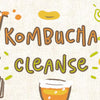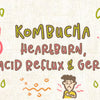Kombucha Bottles: Which Type Of Bottle To Pick? The Complete Breakdown
After the first ferment and brewing are over the time comes to fill your kombucha bottles ready for the second ferment. The first time you do this, you'll always ask: is this the right style of bottle? Size? Material?. We'll explore all of the considerations when deciding on the perfect kombucha bottle for you.
Not Much Time? Skip To What You'd Like To Learn...
-
Which Bottles Are Best For Kombucha?
-
What Makes A Kombucha Bottle Different?
-
Considerations When Picking A Bottle
-
Common Kombucha Bottle Desgins
-
Kombucha Bottle Tops And Lids
-
How To Sterilize Your Bottles For Use
-
Tips For Pouring Your Brew Into The Bottles
-
Where To Store Your Bottled Kombucha
-
FAQ's
Which Bottles Are Best For Kombucha?
We would recommend the flip-top 10oz (around 300ml) glass bottle. A secure lid, pressure tested glass it's the perfect size to put in your bag and sip on throughout the day.
What Makes A Kombucha Bottle Different?
The most significant difference is that the lid is re-sealable and contains the carbonation better. A kombucha bottle can be found just like any other bottle in your local grocery store or online stores such as amazon.
Considerations When Picking A Bottle

Material - Glass is the most recommended material. When bottling your 'bucha you want to know that the material it's sat in won't influence the taste. Glass is seen as inert, meaning it contains the liquid without leaching anything into the drink or changing the taste.
Low-grade plastics can interact with the living probiotics or bacteria, which will cause a change in the kombucha. So if you're using plastic, make sure it's from a reputable supplier that has graded it appropriate for this usage. Another disadvantage of plastic is that it's single-use.
Size Of The Bottle - The most common being bought and sold is the 16oz variation. There are endless options for this consideration. You can buy and use anything from a small 8oz (220ml) to 32oz (1l) bottle. Before buying, think about where you're going to store it, how much kombucha you're brewing, and where are you going to drink it.
If it's just for home consumption, a 32oz bottle in the fridge is often the most convenient. For lunch at work, or you're just looking to test out lots of different flavors then opt for the 16oz variety.
How Many Bottles Do You Need? - Calculate how much kombucha you're brewing so that you can buy the right number of bottles. Most commonly, homebrewer's will brew 1 gallon at a time - 1 gallon = 160oz. So to save money, don't but 3000oz of bottles!
How Many Bottles For My Brew?
1 Gallon |
2.5 Gallons |
5 Gallons |
|
8oz |
20 |
50 |
100 |
16oz |
10 |
25 |
50 |
32oz |
5 |
13 |
25 |
Transparent Or Colored Bottles - In short, either can be used. This factor is dependent on both personal preference and bottle specification.
After flavoring the kombucha can become bright and colorful. If you have clear bottles, the fridge can look amazing and bright. But brown is also another popular style of glass which you can use too. Some older bottles that are bright colors could contain chemicals and toxins that could be very bad for your brew. But all new bottles rated and designed for brewing won't be of any issue.
Environmental Impact - Recycled glass has had a massive revival in recent years. Glass is a versatile material that can be used, broken down, then re-used an infinite number of times. When buying glass be sure to check if it's been recycled or not.
Other materials such as plastic we would recommend avoiding as they're single-use and often it's hard to find recycled plastic too.
Lead-Free - Be sure that all of your bottles are lead-free. Mainly a concern if you're digging bottles out of the back of the cupboard. In times past, some glass was made using toxic materials such as lead. Most commonly crystal and colored designs. When buying be sure only to purchase glass that is rated "100% lead-free".
Lid Style - There are many styles of lids - for the full breakdown scroll down to the Bottle Top Section. Most commonly people buy hinge or flip lids that are made of food-grade silicone material so that it doesn't change the brew and is airtight too.
Quality Of Glass - It needs to be rated to take the pressure. All glass isn't created equal; some can be thin and weak. When doing a second ferment if you're bottling with thinner glass, you risk having an explosion. An explosion could happen when the gas releases from the ferment; the pressure builds up until smashing the bottle. Make sure your bottle is strong and has been pressure rated to withstand this force.
Common Kombucha Bottle Designs
Our #1 Bottle [16oz]
16oz Bottles

A hinge bottle is the absolute best option for home brewers. They're air tight, easy to secure and can put them in your bag and drink during the day.
[Check The Latest Price On Amazon By Clicking
This Link]
Boston Round Bottle
A round-shaped bottle typically with a screw-on lid. Looking like a pharmacy or chemist style of bottle. The design of the bottle is very simple, coming in sizes from 8oz to 32oz. Great for a homebrewer.
Factfile

-
Material - Glass
-
Size Of Bottle - 8oz to 32oz
-
Color Of Bottle - Commonly transparent or brown
-
Environmental Impact - Can be sourced as a recycled product
-
Lead-Free - Yes, most modern bottles will be lead-free
-
How Many Bottles? - Check brew amount
-
Lid Style - Screw-on, metal or food-grade plastic
Advantages
-
Easy To Find - Commonly available online and in stores
-
Low Price - You can source this bottle from $1.2 - $2 per piece
Beer Bottle
 Using the typical beer bottle for your fermented kombucha tea is a great solution. Possibly the most common solution too. Beer bottles have been used for hundreds of years and known to be a proven design.
Using the typical beer bottle for your fermented kombucha tea is a great solution. Possibly the most common solution too. Beer bottles have been used for hundreds of years and known to be a proven design.
Factfile
-
Material - Glass
-
Size Of Bottle - 8oz to 32oz
-
Color Of Bottle - Commonly transparent or brown
-
Environmental Impact - Can be sourced as a recycled product
-
Lead-Free - Yes, most modern bottles will be lead-free
-
How Many Bottles? - Check brew amount
-
Lid Style - Hinge lid, crown lid
Advantages
-
Easy To Find - Commonly available online and in stores
-
Low Price - You can source this bottle from $1.2 - $2 per piece
Wine Bottles
 The reason for this is because of the potential for further carbonation if there is lots of sugar left the pressure will build up when fermenting — causing the cork to blow, leaving you with a severe case of Kom-Boom-Cha! So when using this method, take precaution. Rarely seen or sold commercially, you could use a wine bottle for a second ferment. Two big points to watch out for, is how much sugar is left? Is the cork wired down?
The reason for this is because of the potential for further carbonation if there is lots of sugar left the pressure will build up when fermenting — causing the cork to blow, leaving you with a severe case of Kom-Boom-Cha! So when using this method, take precaution. Rarely seen or sold commercially, you could use a wine bottle for a second ferment. Two big points to watch out for, is how much sugar is left? Is the cork wired down?
Factfile
-
Material - Glass
-
Size Of Bottle - 6oz to 1,014oz
-
Color Of Bottle - Commonly green
-
Environmental Impact - Can be sourced as a recycled product
-
Lead-Free - Yes, most modern bottles will be lead-free
-
How Many Bottles? - Check brew amount
-
Lid Style - Cork
Advantages
-
Easy To Find - Commonly available online and in stores
-
Low Price - You can source this bottle from $1.5 per piece
Mason Jars
Yes you can store your kombucha in a mason jar. But it probably isn't the best for regular consumption, pouring or taking for lunch in the office.
 Factfile
Factfile
-
Material - Glass
-
Size Of Bottle - 6oz to 128oz
-
Color Of Bottle - Transparent
-
Environmental Impact - Can be sourced as a recycled product
-
Lead-Free - Yes, most modern bottles will be lead-free
-
How Many Bottles? - Check brew amount
-
Lid Style - Screw-on or hinge; Material: metal, plastic, silicon
Advantages
-
Easy To Find - Commonly available online and in stores
-
Low Price - You can source this bottle from $1.5 per piece
Kombucha Bottle Tops And Lids

When choosing the type of lid for you fresh batch, you're limited by the design of bottle and materials available. Many bottles, especially those branded and marketed as "kombucha bottles," are increasingly coming with hinged lids prebuilt into them and fewer options for customization and personal choice.
So if you're looking to pick the perfect lid or just picking a bottle with an integral lid, there are some considerations before buying.
The most crucial factor when picking a lid is how tight it holds the carbonation if it lets all of the CO2 leak it will leave you with a flat brew.
Material Of Lids
-
Metal - To ensure the best brew, we would avoid metal. Due to the acidic nature of kombucha, we wouldn't recommend kombucha being able to touch any metal. Although it is possible that under certain circumstances and certain types of metal, it can be completely fine - we wouldn't recommend it to homebrewers who are starting.
-
Silicon - Most commonly used for the hinge style lids - the silicon forms an airtight seal. Silicon is known as inert material so wouldn't compromise the taste, flavor, or culture of your kombucha. We would recommend a silicone lid.
-
Plastic - Even if the plastic is rated food safe, the type we need is high-density plastic that has been rated suitable for fermentation. Some brewers will avoid plastic at all costs, but other commercial brewers have started to use it — very much a case of quality and personal taste.
Style Of Lid

Hinge Lids - A style of a lid that clamps the lid down over the top of the bottle. The hinge clamps the lid into place, forming an airtight seal. Often characterized by the metal device being fastened to the neck of a glass bottle with a lid being attached.
The most recommended bottle lid style on the market currently for ease of use, refastening ability, and airtight fit.
Twist Lids - The most simple of all lids. A screw-on lid is where there is a thread on the bottle and in the lid too. The lid forms a seal with the bottle that can be removed when you're looking to drink from it and refastened for storage.
Cork - Coming from timber, cork is an old fashioned way to secure g lass bottles of to preserve fermented beverages. Most notably known to keep carbonated wines and champagnes safe.
lass bottles of to preserve fermented beverages. Most notably known to keep carbonated wines and champagnes safe.
While it is possible to use this method as a lid, we wouldn't recommend it. The extra effort to properly secure it with a wire cage, also the inability to restore in the fridge without spoiling, making it more of a single-use solution.
The only time we would use this solution of the cork is if we're gifting this beverage as is a nice touch for a birthday or Christmas present.
Crown Lids - The type of lid you see on a bottle of beer. It has been clamped over the top of the glass to create an airtight seal and not let any gas escape.
Crown lids are great in theory, but if you're at home, you'll have to get a bottling machine and not very handy when trying to consume when out of the house. The drawbacks of having to drink it all at once and added expense rarely make crown lids something we would recommend.
More ideal if you're a small batch brewer selling your kombucha tea.
How To Sterilize Your Bottles For Use
When you're ready to start the bottling process, you need to sterilize your bottles. As the kombucha is very sensitive to any contamination, all your equipment and bottles need to be clean. There are a few methods for killing all of the bacteria in your bottles.
Note: we can't use any antibacterial soaps, dishwasher tablets, or bleach during the sterilization process. Using them could kill all of the probiotics in our kombucha.
Note #2: Going from a very cold temperature to hot can be dangerous or cause your glass to shatter. Most glass jars have been rated for temperature change. So check with the manufacturer ratings to see if your jar can withstand these changes.
Method #1 Hot Water

Be very careful when doing this as you'll be pouring hot water.
-
Boil water in a large pan
-
Once boiled transfer the water to your vessel and let the vessel stand with hot water in it until cool.
-
Empty when cool
Method #2 Hot Water Bath

Similar to canning you can use a bath of hot water to sterilize your jars
-
Fill a pan full of water
-
Add a canning stand and your bottles
-
Bring to boil and leave it there for 20 minutes
-
Remove with tongs when ready
Method #3 Dishwasher

-
Place your bottles in the dishwasher
-
Do not use the dishwasher tabs, liquid or powder
-
Put it on a hot wash and remove once finished
Tips For Pouring Your Brew Into The Bottles
-
Only Use Plastic Or Silicon Instruments - make sure not to use a metal funnel, whisk or equipment. This will interfere with the brew.
-
Strain To Get Rid Of Goo - Often there will be some stringy goo left in the vessel after you remove the scoby, this is safe to consume. If you find it unpleasant, then run your brew through a cloth to strain.
Remove Your Scoby Carefully - A suitable method to remove the mother scoby and new baby scoby is by first cleaning your hands thoroughly using filtered un-chlorinated water, or running vinegar over them. Don't use any handwashes or antibacterial soaps before handling a scoby.
Where To Store Your Bottled Kombucha
Your ferment has finished, your bottling is complete now it's time for storage. Bottled kombucha can be left in the pantry or another dry, dark area for a few days to carry on fermenting.
After this period, we would recommend fridge storage. The temperature of a fridge is low meaning that it will slow down any bacteria growth, thus slowing fermentation and keeping the most consistent taste.
If you have to store it outside of the fridge, don't worry, it will still be tasty and satisfying. Just likely to go a little more sour over a long-term period.
FAQ's
Does Kombucha need to be in a dark bottle?
No - kombucha could be bottled in any color of the bottle. The most common are transparent and brown bottles.
Do I need to sterilize bottles for kombucha?
Yes! We would strongly recommend sterilizing all materials before use - glass included! Especially as kombucha contains bacteria, we don't want any contamination or danger.
How much Kombucha should you drink a day?
There's no clear answer. Some people have reported stomach problems, excess gad, and being uncomfortable when drinking very high amounts.

 Using the typical beer bottle for your fermented kombucha tea is a great solution. Possibly the most common solution too. Beer bottles have been used for hundreds of years and known to be a proven design.
Using the typical beer bottle for your fermented kombucha tea is a great solution. Possibly the most common solution too. Beer bottles have been used for hundreds of years and known to be a proven design. The reason for this is because of the potential for further carbonation if there is lots of sugar left the pressure will build up when fermenting — causing the cork to blow, leaving you with a severe case of Kom-Boom-Cha! So when using this method, take precaution.
The reason for this is because of the potential for further carbonation if there is lots of sugar left the pressure will build up when fermenting — causing the cork to blow, leaving you with a severe case of Kom-Boom-Cha! So when using this method, take precaution.  Factfile
Factfile lass bottles of to preserve fermented beverages. Most notably known to keep carbonated wines and champagnes safe.
lass bottles of to preserve fermented beverages. Most notably known to keep carbonated wines and champagnes safe. 






Hi growyourpantry.com webmaster, You always provide helpful diagrams and illustrations.